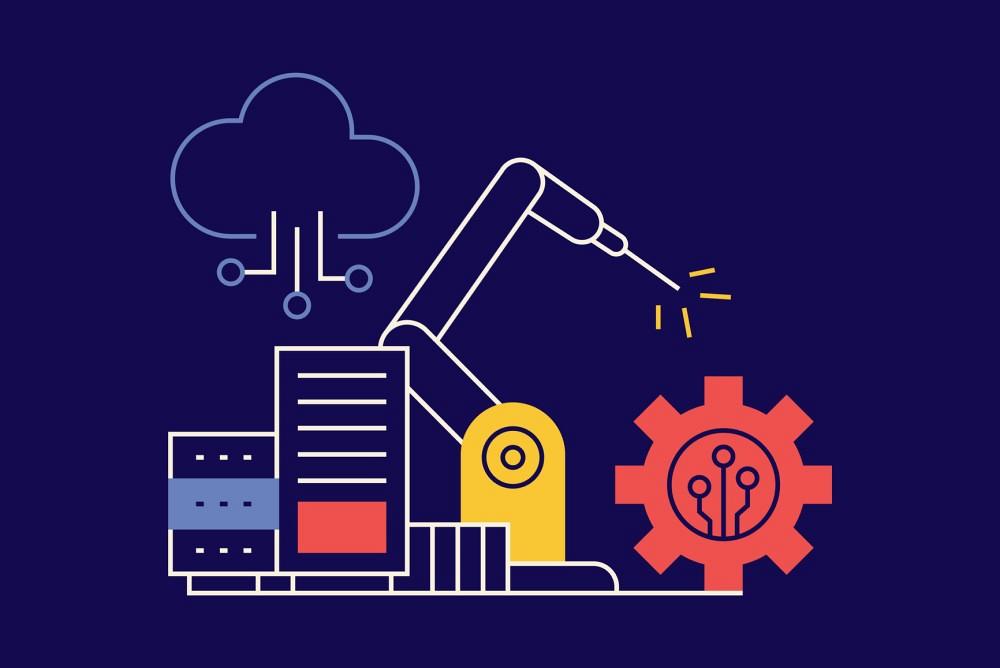CEO/Co-founder
- FMA
- The Fabricator
- FABTECH
- Canadian Metalworking
Categories
- Additive Manufacturing
- Aluminum Welding
- Arc Welding
- Assembly and Joining
- Automation and Robotics
- Bending and Forming
- Consumables
- Cutting and Weld Prep
- Electric Vehicles
- En Español
- Finishing
- Hydroforming
- Laser Cutting
- Laser Welding
- Machining
- Manufacturing Software
- Materials Handling
- Metals/Materials
- Oxyfuel Cutting
- Plasma Cutting
- Power Tools
- Punching and Other Holemaking
- Roll Forming
- Safety
- Sawing
- Shearing
- Shop Management
- Testing and Measuring
- Tube and Pipe Fabrication
- Tube and Pipe Production
- Waterjet Cutting
Industry Directory
Webcasts
Podcasts
FAB 40
Advertise
Subscribe
Account Login
Search
What can AI do for metal fabricators?
Artificial intelligence is the future, but what can it do now for the metal manufacturing industry?
- By Caleb Chamberlain
- September 19, 2023
I recently tried to reach a customer support rep at a large social media company—one you’ve heard of but that I won’t name. Our advertising account had been disabled when someone tried to hack into our social media manager’s account. Predictably, it was a fiasco. The ad account was disabled automatically by an algorithm, and after weeks of back and forth, nobody in the company seemed to know why it happened or how to fix it. As I write this article, our digital ads on that platform are still disabled.
I was initially optimistic. I opened a support ticket and had a conversation with a chat bot. Anyone who has tried to get support from a web chat bot knows what an inauspicious start that was, but when I asked to talk to a human, I was pleasantly surprised to be connected almost immediately.
Stephanie was unfailingly polite and diplomatic, empathetic, and supportive. But as we chatted, I had a growing feeling that something wasn’t quite right. Stephanie seemed to forget the context of the conversation every few exchanges, asked multiple times to confirm the account numbers, and used diplomatic language that sounded great but meant nothing. She couldn’t tell me what was actually happening but assured me that “the team” (whoever that is) was working ever so hard to resolve the issue. That was a month ago.
It suddenly hit me that I almost definitely wasn’t talking to a human. I can’t prove it, but I’ve spent enough time tinkering with large language models (LLMs) like ChatGPT to pick up on their eccentricities. I think that this company pretended to connect me with a human but sent me instead to a modern AI.
An Ode to AI
I want to be excited about LLMs. When ChatGPT was publicly released in late November 2022, the world all but went crazy. Curious about the hype, I created an account and started tinkering. I gave it this prompt: “Write a limerick about getting kicked in the head during a martial arts tournament,” and here’s what it gave me:
In a martial arts tourney one day,
A swift kick came flying my way.
I tried to defend,
But alas, in the end,
On the mat, I unwillingly lay.
I was floored! Consider the leaps of insight required to produce something even so short and seemingly simple: it understood what it meant to write a limerick; it shortened “tournament” to a more colloquial (and conveniently syllabic) “tourney;” it connected martial arts to “the mat;” it understood that getting kicked in the head might put you on the ground; and it put all those concepts together into a limerick with correct rhyme and meter.
If ChatGPT only wrote limericks, it’d still be impressive enough. But it can write poetry, develop software, edit writing, draft responses to emails, imitate accents and people, prepare marketing copy … the list goes on. It’s the closest thing to true generalized artificial intelligence I’ve ever seen. Other AI models can generate convincing images from a text prompt, or even mimic human speech.
You can try it yourself for free at OpenAI.com. But as you have conversations with it, you’ll start to pick up on its limitations. It’s clever and knowledgeable, but it’s also weirdly stupid. Or inhuman, maybe. It’s conversant enough that you expect it to act like a human, but it isn’t. ChatGPT will invent facts and present them with confidence (people call that hallucination), and it will forget context.
Everything Will Change, Just Not Yet
Even so, the writing is on the wall. This technology will change the world. And while it’s difficult to predict where this is all going to end up, that’s not stopping the world’s most powerful and wealthy companies from going all in. If the technology is so incredible right now, imagine where it’ll be in 10 years.
Like I said, I want to be excited. But I’ve already had one big company deceptively connect me to an AI with frustrating (and business-affecting) outcomes. And I’m already receiving AI-generated spam in my email inbox and my LinkedIn account. AI can affect the world positively, I’m sure. But uncertain positives are counterbalanced by almost-guaranteed negatives.
Students are already using the technology to cheat. While there are efforts to detect AI-generated writing, I suspect it’s a losing battle. Even OpenAI (the developer of ChatGPT) revealed that its own detection tool is unreliable, only correctly identifying AI-generated content about a quarter of the time, and falsely flagging human-written text as AI-generated 9% of the time. If used in its current state, OpenAI’s classifier would let 75% of cheaters walk away free and accuse 10% of the innocent. That’s not great odds. As LLMs become more capable, it will probably get worse.
It’ll affect the value of information on the internet as well. The internet has in some ways already become a wasteland of worthless content, written to manipulate search engines instead of to provide actual informative value. LLMs weaponize and advance that trend, making it possible to publish bland, irrelevant content at an unprecedented rate. If finding actual insight from actual people on the internet was hard before, it’ll become all but impossible in the future. Sure, AI will become better. But even then, I’m wary about a future in which creative writing and art become the domain of computers instead of people.
Meanwhile, companies won’t be able to resist the clarion call of automated, AI-driven customer support. Why pay a person to develop relationships with customers if instead you can trick them into talking to an AI, customer experience be damned?
AI Has Left the Station
Whether we like it or not, though, there’s no getting off this train. And if we can’t avoid it, we might as well join in. I’ve found myself wondering how I might apply LLMs to my own manufacturing business, but for the life of me, I can’t come up with a single application that isn’t better solved using more traditional tools, at least for now. Maybe that’s a sign of my own lack of imagination.
I mean, I guess I could fine-tune a model to respond to customers automatically, making their experience a little worse, and our payroll marginally lower. But chasing the bottom line at customers’ expense doesn’t sound like a winning strategy. In fact, customer experience has been a big driver of our own shop’s growth, at every step from quote to part. We use a lot of software automation, but we focus on tools that make customers’ lives easier, not harder. Sometimes, you have to know when not to use a new tool.
Perhaps an LLM could be used to analyze parts or predict production bottlenecks, but it’s really not the right tool for the job. It would be easier and more correct to analyze manufacturability from first principles than to train a text-based AI to do it: for example, a bend simulation can actually detect collisions with tooling. An AI model couldn’t do that, no matter how great it is at writing limericks or mimicking famous politicians.
The same could be said for scheduling. In last month’s article, I wrote that Monte-Carlo simulations are the nearest thing to a silver bullet there is for estimating lead times and predicting production outcomes. That’s a statistical tool. It has nothing to do with AI.
AI might be trained to detect quality defects on parts, but again … why? Identifying, measuring, and analyzing parts with machine vision is a solved problem, and an LLM doesn’t add anything helpful to the mix. Training a generative AI to find quality defects in an image would be like tightening a bolt with zip ties and popsicle sticks. You could probably figure out a way to do it, but why not grab a wrench instead?
AI could help fine-tune our website and ad copy or edit emails to adjust their tone. That’s at least something practical and imminently helpful, but it’s a small quality of life improvement, not an earth-shattering transformation of how we do business.
AI could affect some areas of the office, including the actual writing of low-code, custom apps tailored for unique scenarios. And, of course, every job shop has plenty of unique situations, especially when it comes to scheduling and workload balancing. Custom metal fabricators perform a juggling act every day, and each has a different way of managing it. Here, AI could lend a hand.
Beyond that, though, we still make physical parts for the physical world. No matter how sophisticated the automation, an old-fashioned human has to get involved. That’s a good thing for manufacturers. I have my fingers crossed that it’ll remain that way. I’m not certain that a world that doesn’t need humans is a better one, no matter how exciting the technology that takes us there.
subscribe now

The Fabricator is North America's leading magazine for the metal forming and fabricating industry. The magazine delivers the news, technical articles, and case histories that enable fabricators to do their jobs more efficiently. The Fabricator has served the industry since 1970.
start your free subscriptionAbout the Author

Caleb Chamberlain
165 N. 1330 W #C4
Orem, UT 84057
801-850-7584
- Stay connected from anywhere

Easily access valuable industry resources now with full access to the digital edition of The Fabricator.

Easily access valuable industry resources now with full access to the digital edition of The Welder.

Easily access valuable industry resources now with full access to the digital edition of The Tube and Pipe Journal.
- Podcasting
- Podcast:
- The Fabricator Podcast
- Published:
- 04/16/2024
- Running Time:
- 63:29
In this episode of The Fabricator Podcast, Caleb Chamberlain, co-founder and CEO of OSH Cut, discusses his company’s...
- Trending Articles
Tips for creating sheet metal tubes with perforations

JM Steel triples capacity for solar energy projects at Pennsylvania facility

Are two heads better than one in fiber laser cutting?

Supporting the metal fabricating industry through FMA

Omco Solar opens second Alabama manufacturing facility

- Industry Events
16th Annual Safety Conference
- April 30 - May 1, 2024
- Elgin,
Pipe and Tube Conference
- May 21 - 22, 2024
- Omaha, NE
World-Class Roll Forming Workshop
- June 5 - 6, 2024
- Louisville, KY
Advanced Laser Application Workshop
- June 25 - 27, 2024
- Novi, MI



























